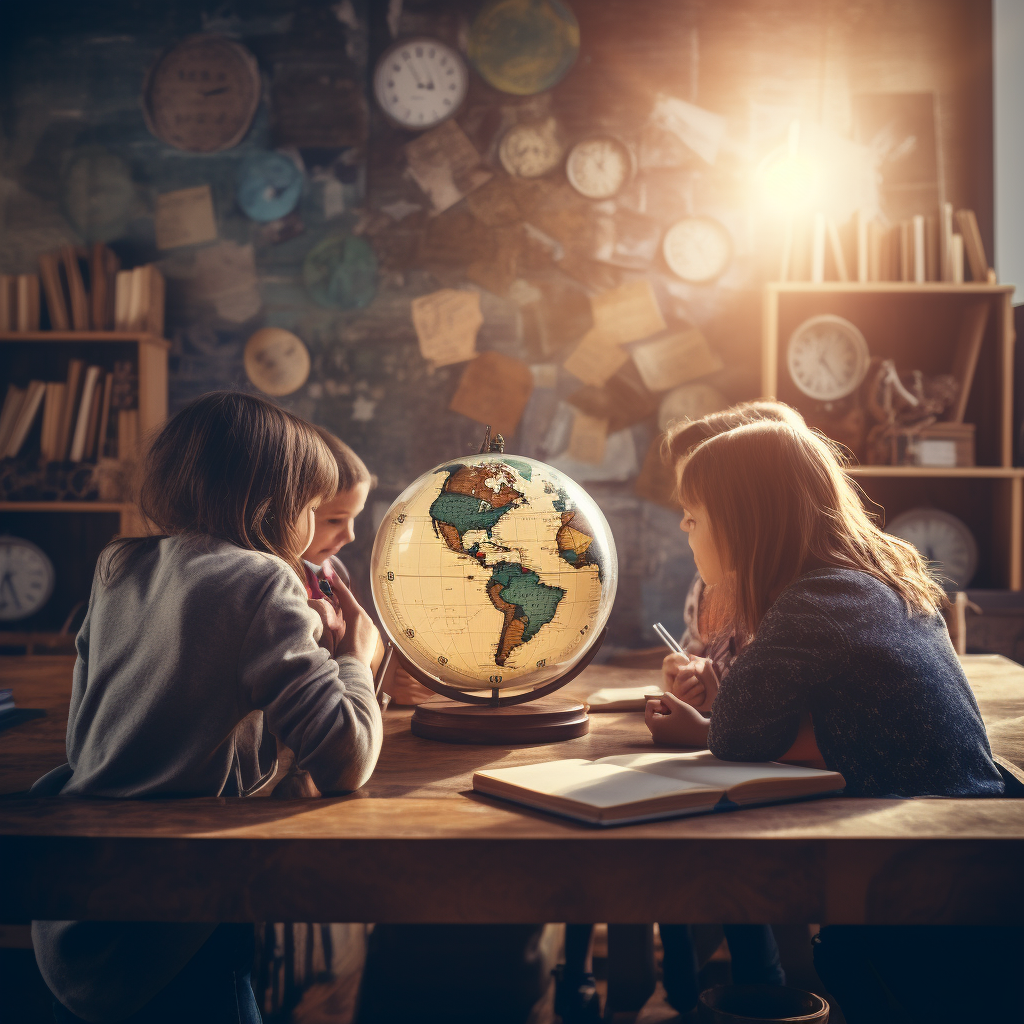Real-world learning experiences are increasingly becoming a part of the school day. These experiences can help illustrate the relevance of academic concepts and provide students with important skills for their future career paths. By fitting in real-world learning experiences in the school schedule, schools can better equip students with the knowledge and life experiences they need to be successful beyond the classroom. Examples of real-world learning include field trips, guest speakers, job shadows, service projects, internships, and connecting in-class learning to real-world settings.
Overview of the importance of real-world learning experiences
Real-world learning experiences are important for students’ educational and personal growth. These types of experiences can help students learn critical-thinking skills, problem-solving strategies, and how to communicate effectively. By participating in real-world learning experiences, such as virtual internships, volunteer activities, and job shadowing, students can gain valuable real-world knowledge and experience, develop their skills, and learn about meaningful career paths.
When it comes to incorporating real-world learning experiences into a schedule, it is important to consider the individual student’s needs and interests. Students should be offered a variety of meaningful experiences that both challenge and engage them. For example, a student can shadow a professional career in their field of interest or volunteer with a local organization. Furthermore, teachers and administrators should be mindful of their students’ scheduling conversations and adjust their instruction plans to give students time to take part in these types of real-world learning opportunities.

Benefits of Real-World Learning Experiences
Real-world learning experiences offer invaluable opportunities for students to directly engage with their subject matter and solidify their understanding of the concepts they learn in the classroom. When included in the schedule, real-world learning experiences help students develop important skills, such as problem-solving, collaborative work, and independent study.
Real-world learning experiences can be included in the school schedule by integrating activities such as field trips, student internships, volunteer opportunities, or even virtual learning experiences into the curriculum. Utilizing these low-cost activities injects real-life context into the class and provides students the necessary skills to succeed.
At the elementary and middle school level, field trips to local or nearby sites can provide interesting activities that help students understand the subject matter. High school students may have the opportunity to explore their interests in more depth through internships or volunteering in their community. Finally, with the increased use of technology, virtual learning experiences can also be included in the schedule as a way to bring the “real world” into the classroom and provide a unique educational experience for students.
Hands-on learning
Hands-on learning involves providing students with the opportunity to participate in activities that apply the knowledge and concepts they are learning in school. This type of learning is beneficial for many reasons. It can give students a better understanding of a concept by engaging with real-life situations, help them develop problem-solving and critical thinking skills, and encourage self-confidence.
When incorporating hands-on learning experiences into the school’s schedule, teachers should identify the skills and concepts that can best be learned through hands-on experiences and design a lesson plan with fun and engaging activities. Examples of hands-on activities include field trips, virtual labs, simulations, group projects, experiments, and guest speakers. These activities should also be cross-disciplinary and accessible to all students in order to maximize their effectiveness. Supervision by an experienced teacher is essential in order to ensure that students remain safe and on-task during these activities.

Problem-solving
Problem-solving in this context can involve providing opportunities for students to approach real-world learning by simulating real-world scenarios in their classrooms. This could include activities such as a mock job interview, a simulated business meeting, problem-solving through debates or group projects, or simulations of real-world situations such as natural disasters or political situations. In addition, including field trips, guest speakers, and community service projects can give students direct exposure to real-world challenges. These experiences can help provide students with valuable skills and understanding of how to apply solutions in real-world settings.
Critical thinking
Critical thinking is an important skill to include in any lesson or learning experience. When incorporating real-world learning experiences, it is important to pose questions to the students that will require them to apply critical thinking skills in order to answer or discover a solution. These questions should be open-ended, avoid having a “right” or “wrong” answer, and should encourage active reflection and analysis. Questions should also be designed to challenge the student’s viewpoints, and encourage further exploration and knowledge acquisition, while also considering the diversity of opinions from all participants. Fostering constructive dialogue and discussions is also important to ensure the students can form their own opinions while respecting the opinions of others. Finally, it is important to allow for active exploration, rather than just rote memorization of facts and figures, in order to fully foster critical thinking skills as part of any learning experience.
Encourage creativity
One way to encourage creativity while including real-world learning experiences in the schedule is to plan experiences that expose the students to multiple facets of the topic/theme being discussed. For example, if teaching about a specific geographic location or culture, field trips to historic landmarks, zoos, museums, and similar places of interest could allow for a multi-sensory experience. Invite guest speakers from the local community or from outside who can bring a first-hand account and perspective on the topic being discussed. Have students write a play, make a podcast, or create artwork to help bring the topic to life. Incorporating multiple mediums into the learning experience can be a great way to ensure students are engaging with the material in an exciting and creative way.
Increased engagement
Real-world learning experiences can be included in the schedule by allowing students to have hands-on activities that take place off-campus. For example, field trips to museums or other nearby attractions can be used to engage students in learning about different topics or disciplines. This type of experience can also be used to inspire students to explore or learn more on their own time in order to gain a better understanding of the world around them. This can lead to increased engagement in class discussions and overall education.
Setting Priorities for Real-World Learning Experiences
When looking at how to include real-world learning experiences in the schedule, it is important to set priorities. Prioritize experiences that tie tightly to curriculum objectives to ensure that students gain valuable learning experiences from activities in the real world. The priority should also be given to activities that will garner maximum engagement from students, such as field trips, hands-on activities, and guest speakers. Make sure to also set aside time for reflection and discussion, as this will allow students to delve deeper into their real-world learning experiences and gain the most from their experiences. In addition, ensuring that real-world learning experiences are integrated throughout the school year can help to sustain student interest and maximize the learning value of these experiences.

Strategically schedule learning experiences
Real-world learning experiences can be strategically scheduled into the class curriculum to help extend students’ existing classroom knowledge in an engaging and meaningful way. For example, a field trip to a local museum, farm, or nature preserve could be used to teach a unit on local history, natural sciences, or economics. Additionally, performing tasks such as volunteering, completing online courses, or participating in internships and job shadows can provide real-world learning experiences that help to build skills and industry knowledge. Real-world learning experiences could also be planned for the end of the school year to allow students to apply their academic knowledge and gain insight into potential career paths.
Prioritize student needs
A. Prioritizing student needs is essential when considering how to include real-world learning experiences in the schedule. It is important to consider the individual student’s interests, abilities, and learning styles, as well as family and financial situations, when selecting activities and field trips. Working with student input, educators can create activities that are meaningful and relevant to the students while ensuring that their learning is stimulating, engaging, and accessible. When possible, incorporate resources from the local community into the activities, such as speakers, field trips, or hands-on activities that showcase a student’s aptitude or specialty. Also, involve families and the community as much as possible for a more rewarding educational experience.
Utilize student-led teaching
Student-led teaching is a great way to include real-world learning experiences in the schedule. It allows students to take ownership of their own learning, think critically about the material, and create an engaging environment. In student-led teaching, the teacher acts as a facilitator, helping the students explore and solve the problem at hand, rather than simply delivering a lecture. This can include breaking the class up into smaller groups and giving each group a different problem to work through, or allowing students to collaborate as a whole class in order to come up with a creative solution. The teacher can also provide resources like books, websites, videos, etc. for the students to use in order to further their knowledge and develop their understanding of the material. This type of learning experience creates a dynamic classroom environment where students can learn by engaging actively rather than passively listening.
Finding Time for Real-World Learning Experiences
Real-world learning experiences can be invaluable for students of all levels, and providing these experiences does not have to be a time-consuming endeavor. Here are a couple of strategies to help you fit real-world learning experiences into your classroom schedule:
1. Utilize microlearning. These are small, bite-sized learning sessions that can fit neatly into any lesson plan. For instance, if you are teaching a unit on Earth Science, have students complete a short-form field trip and take part in activities such as data collection or mapping that can be completed in a short amount of time within the classroom.
2. Leverage technology. Technology is a great way to virtually explore the world right within the classroom. Consider interactive simulations and games that enable students to explore a variety of environments from their computers, tablets, or phones.
3. Blending content with real-world applications. Throughout your teaching, find ways to emphasize real-world examples and applications to the material and provide students with opportunities to discuss and debate real-world scenarios.
Real-world experiences can be incorporated into almost any lesson. Finding the right balance of virtual, in-class, and field experiences can help enrich your students’ understanding of the material and better equip them for the realities of their future.
Leverage resources
Real-world learning experiences can be integrated into the schedule in a variety of ways. One way to do this is to leverage resources in the local community, such as businesses, organizations, and other educational institutions. For example, you could organize field trips to explore local landmarks or businesses, arrange partnerships with local organizations to facilitate job-shadowing or guest-speaker opportunities, or invite outside experts to lecture or provide demonstrations in your classroom. Additionally, you may be able to arrange a co-teaching experience with a teacher at another school, or offer internships or service-learning opportunities for your students. Finally, you can take advantage of online resources such as webinars, virtual museum tours, and online videos and interactive games to introduce students to real-world concepts.
Re-think teaching approaches
Re-thinking teaching approaches can involve connecting classroom activities to real-world situations or problems. For example, asking students to research a current event and then apply the material they have learned in the curriculum to analyze the issue. At the same time, you could encourage students to use their creativity and collaborate on solving a problem with a real-world application. This could include having students conduct research around customer feedback and develop ideas or plans that could be implemented in a company. You could also give students the opportunity to shadow a professional and learn first-hand what it takes to do a certain job. Alternatively, you could encourage students to use technology platforms to connect with professionals in various industries to learn more about how they approach their work and the challenges they face.
Make the most of available time
Real-world learning experiences provide hands-on and authentic learning opportunities to students that extend beyond the traditional classroom curriculum. In order to make the most of available time, it may be helpful to incorporate short field trips and outdoor lessons into the schedule. Field trips allow students to explore different areas and ask questions about the world around them. Using outdoor learning opportunities gives students an opportunity to interact with natural resources and engage in research activities in the field. Additionally, incorporating guest speakers into the regular classroom schedule can add a layer of reality to the learning process. Inviting community members to speak to students about their professional and personal experiences helps to create a connection between students and experts in the field. When combined with short field trips and outdoor learning opportunities, these types of practical, real-world experiences can create an exciting and relevant atmosphere for students to learn in.

Tips for Incorporating Real-World Learning Experiences
1. Provide field trips: Take the classroom outside and explore a local museum, zoo, or historic site, or go on a field trip to learn more about a particular topic or industry.
2. Connect current events: Monitor the news and discuss how the current headlines relate to course topics or curriculum objectives
3. Invite guest speakers: Invite professionals from the field to come in and talk to the class about their experiences and perspectives.
4. Community service learning: Require students to work in the community, such as a volunteer program or an internship, to gain real-world experience.
5. Participate in a simulation: Change up traditional lectures with hands-on activities such as simulations or role-play activities to test out their skills in a real-world setting.
6. Use technology tools: Let students use technology tools such as video conferencing and virtual reality to explore a certain topic or industry.
7. Encourage a project-based approach: Have students design and execute a project related to the course material, whether it’s a research project, an online campaign, or a product or service.
8. Create a professional portfolio: Ask students to create a professional portfolio that they can use to reflect on their work and experiences.
9. Promote professional development: Encourage students to attend networking and professional development events or gain experience through an internship to help them explore career options
Use simulations
Simulations are a great way to bring real-world experiences into the classroom. For example, students can act as employees in a simulated business enterprise and take on roles that they would in a real-world company. They can make decisions, work with others, and problem solve, giving them a taste of the real world. This can be done by providing students with a set of activities that use resources they wouldn’t usually have access to in the classroom, such as industry experts. Additionally, it can give teachers the opportunity to assess their students’ understanding in a realistic context, allowing them to really see the impact of their teaching. Finally, simulations can also allow students to learn where to access reliable and useful information, as well as how to evaluate data and make productive decisions.
Try ‘real-world’ projects
Real-world projects are activities that involve students bringing their skills to life in the “real world” outside of the classroom. Examples of real-world projects include developing a school garden, creating a webcomic, making a video documentary, creating a 3D printed sculpture, or designing a mobile app. These projects allow students to use their knowledge and skills to create something that has an impact in the “real world.”
In order to include real-world learning experiences in the schedule, start by finding out what activities students are interested in and try to build the project around that. Once you have identified the project, create an achievable timeline with milestones for completion. Make sure to also create an assessment plan to evaluate the quality of student work and track their progress. Additionally, establish parameters for collaboration or individual projects and set clear lines of communication between teachers and students. Finally, emphasize the importance of the project and its impact on the world.
Host guest speakers
Hosting guest speakers is a great way to invite real-world learning experiences into the classroom. Inviting guest speakers from the professional world can add valuable insight into a given topic and give students a sense of what it is like to practice in the field. This can be done in an informal setting, such as inviting a guest to attend a class, or in more formal settings, such as planning a field trip for students to visit a particular business or organization. Inviting guest speakers can be highly effective, and gives students the opportunity to interact with experts in the field, ask questions, and gain a better understanding and appreciation of the subject matter.
Explore the outdoors
Real-world learning experiences can be included in the schedule by exploring the outdoors. For example, students can take a nature walk to observe the wildlife and learn about the local environment and its important features. They can also take part in outdoor games that require collaboration and communication skills, such as Capture the Flag. Visits to nearby farms and public gardens can also be scheduled to provide insight into the world of farming and the environment. Finally, team-building opportunities in the form of geocaching or orienteering can also be included to help students learn important navigational and problem-solving skills.
Conclusion
Real-world learning experiences can be included in a schedule through hands-on activities that allow students to apply what they are learning in class to real-world scenarios. For example, if students are studying the principles of marketing, they could go on a field trip to an advertising agency or a manufacturer to learn more about the production and promotion of a product. Additionally, students could visit a local charity or business to understand how the company works and figure out how it contributes to the community. Finally, students could take part in virtual internships to get hands-on experience and network within the industry. By providing students with opportunities to apply their classroom knowledge in practical ways, they can become better prepared for the realities of the working world.
